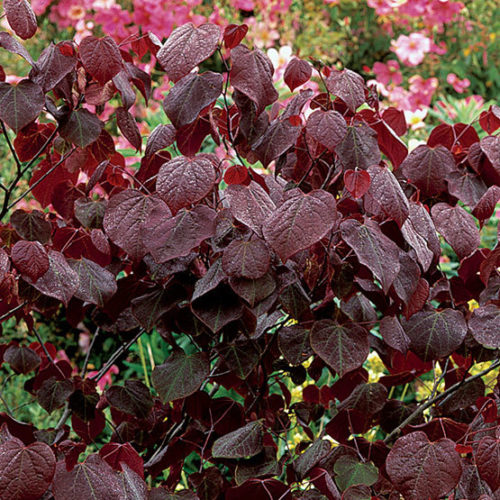Gardening With Forest Pansy Redbud
The existence of Cercis canadensis (Forest Pansy Redbud) spans extensive periods while being closely linked to both natural and cultural developments throughout North America. Scientific evidence from fossil records reveals that this species lived through millions of years in woodland environments and riverbank habitats. The first populations to understand its value were Indigenous peoples who employed it in practical applications and healing remedies. The early settlers found the tree's striking appearance so appealing that they used it as part of their homesteads and gardens. Through the years, the tree earned its status as an ornamental favorite due to its early spring blooms and continual beauty throughout the seasons.
The species earned official documentation from European botanists in the 17th century because they found its foliage unique and its flowers striking. The spread of botanical exploration led to its introduction across global cultivated landscapes. The tree continues to attract admiration today as it beautifies gardens and parks as well as urban spaces throughout various climate zones.
Forest Pansy Redbud Traditional and Modern Medicinal Uses
Indigenous populations utilized Forest Pansy Redbud's medicinal properties for generations. Native Americans brewed the bark and inner wood into herbal teas to treat conditions like fever and inflammation, along with congestion. Certain tribes found relief for digestive problems through its use, while other tribes applied it to wound care by making healing poultices.
Contemporary herbalists investigate its capabilities for antioxidant properties and inflammation reduction. Research findings indicate potential health benefits from its compounds, even though it is not widely used in modern medical practices. The species maintains its importance within traditional herbal practices even though it remains relatively unknown in pharmaceutical circles.
Discovery and Botanical Recognition
European explorers first documented Cercis canadensis in the early 1600s, although Indigenous peoples had long recognized its presence. The English botanist John Tradescant the Elder became one of the earliest people to document this species after he discovered specimens during his North American travels. The plant became popular in European gardens because its captivating blooms intrigued him. The species underwent extensive research, which demonstrated its ability to thrive in different environmental conditions.
The plant's Fabaceae family classification reveals its special botanical characteristics. This flowering tree is distinctive because it is part of the legume family which allows it to fix nitrogen and thereby support nearby vegetation. The ecological benefits this species provides ensure its continuous survival in both natural environments and human-created gardens.
Forest Pansy Redbud: A Beautiful Addition to Any Landscape
The striking aesthetic appeal makes Cercis canadensis one of its most captivating features. Heart-shaped leaves appear in early spring to reveal a dynamic range of colors that change throughout the seasons. At first, the leaves exhibit a deep purple color, which advances to green shades when they reach full maturity. During autumn months, the foliage undergoes another transformation to present a stunning exhibition of warm golds and oranges.

Bare branches display dramatic visual contrast when clusters of small pea-like flowers emerge before the leaves appear. These blossoms display colors from soft lavender to deep magenta, which makes them stand out against any landscape. The flowers transform into distinctive seed pods as the season advances, which provides additional visual attraction.
This species consistently attracts attention whether it stands as a garden's main attraction, functions as an understory tree that naturalizes, or serves as an urban setting's focal point. Its refined branching structure, combined with seasonal transformations, renders it suitable for formal gardens and natural landscapes.
Rare Wildlife It Attracts
The Forest Pansy Redbud functions as a vital ecosystem component that supports numerous wildlife species, especially rare and specialized pollinators. Native bees depend on their early-season flowers for nectar, particularly several species of long-tongued bees that need these blossoms as their main food source. The nectar-rich flowers attract hummingbirds who visit frequently when most other plants lack blooms.
The species supports various butterfly and moth larvae as a crucial food source by supporting their caterpillar development. Finches and cardinals, among other songbirds, use their seed pods during late summer and fall. The dense canopy of the tree provides shelter for small mammals and nesting birds, which enhances biodiversity in its growing areas.
Forest Pansy Redbud Hardiness and Adaptability
The resilience and adaptability of Cercis canadensis remain unmatched among ornamental trees. This species grows successfully in multiple soil conditions, including both loamy, well-drained, and clay-heavy substrates. The tree survives moderate drought conditions after establishment, which qualifies it for areas with irregular precipitation patterns.
This tree flourishes across various climates since it can withstand cold temperatures and tolerate heat in both temperate forests and urban settings. The tree maintains its growth and flowering ability despite encountering short periods of extreme temperatures from late frost to the hottest days of summer. The plant shows excellent resistance to typical pests and diseases, which increases its value as a dependable feature for landscapes over time.
Forest Pansy Redbud achieves many decades of growth when gardeners practice proper maintenance by performing periodic pruning and applying mulch to maintain soil moisture. The combination of its urban adaptability with its beautiful appearance and ecological advantages establishes Cercis canadensis as an essential tree for North American landscapes.